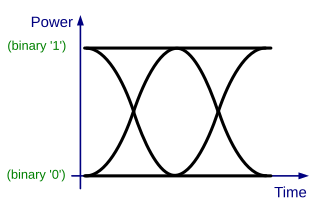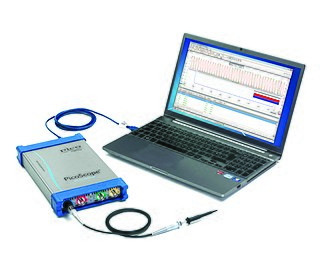
In electronics, an analog-to-digital converter is a system that converts an analog signal, such as a sound picked up by a microphone or light entering a digital camera, into a digital signal. An ADC may also provide an isolated measurement such as an electronic device that converts an input analog voltage or current to a digital number representing the magnitude of the voltage or current. Typically the digital output is a two's complement binary number that is proportional to the input, but there are other possibilities.

A logic analyzer is an electronic instrument that captures and displays multiple signals from a digital system or digital circuit. A logic analyzer may convert the captured data into timing diagrams, protocol decodes, state machine traces, assembly language, or may correlate assembly with source-level software. Logic analyzers have advanced triggering capabilities, and are useful when a user needs to see the timing relationships between many signals in a digital system.

In telecommunication, an eye pattern, also known as an eye diagram, is an oscilloscope display in which a digital signal from a receiver is repetitively sampled and applied to the vertical input, while the data rate is used to trigger the horizontal sweep. It is so called because, for several types of coding, the pattern looks like a series of eyes between a pair of rails. It is a tool for the evaluation of the combined effects of channel noise, dispersion and intersymbol interference on the performance of a baseband pulse-transmission system.
In electronics and telecommunications, jitter is the deviation from true periodicity of a presumably periodic signal, often in relation to a reference clock signal. In clock recovery applications it is called timing jitter. Jitter is a significant, and usually undesired, factor in the design of almost all communications links.
A signal generator is one of a class of electronic devices that generates electronic signals with set properties of amplitude, frequency, and wave shape. These generated signals are used as a stimulus for electronic measurements, typically used in designing, testing, troubleshooting, and repairing electronic or electroacoustic devices, though it often has artistic uses as well.

Electronic test equipment is used to create signals and capture responses from electronic devices under test (DUTs). In this way, the proper operation of the DUT can be proven or faults in the device can be traced. Use of electronic test equipment is essential to any serious work on electronics systems.

A spectrum analyzer measures the magnitude of an input signal versus frequency within the full frequency range of the instrument. The primary use is to measure the power of the spectrum of known and unknown signals. The input signal that most common spectrum analyzers measure is electrical; however, spectral compositions of other signals, such as acoustic pressure waves and optical light waves, can be considered through the use of an appropriate transducer. Spectrum analyzers for other types of signals also exist, such as optical spectrum analyzers which use direct optical techniques such as a monochromator to make measurements.

A waveform monitor is a special type of oscilloscope used in television production applications. It is typically used to measure and display the level, or voltage, of a video signal with respect to time.

Tektronix, Inc., historically widely known as Tek, is an American company best known for manufacturing test and measurement devices such as oscilloscopes, logic analyzers, and video and mobile test protocol equipment.
A video signal generator is a type of signal generator which outputs predetermined video and/or television oscillation waveforms, and other signals used in the synchronization of television devices and to stimulate faults in, or aid in parametric measurements of, television and video systems. There are several different types of video signal generators in widespread use. Regardless of the specific type, the output of a video generator will generally contain synchronization signals appropriate for television, including horizontal and vertical sync pulses or sync words. Generators of composite video signals will also include a colorburst signal as part of the output.

A test probe is a physical device used to connect electronic test equipment to a device under test (DUT). Test probes range from very simple, robust devices to complex probes that are sophisticated, expensive, and fragile. Specific types include test prods, oscilloscope probes and current probes. A test probe is often supplied as a test lead, which includes the probe, cable and terminating connector.
In telecommunication, a measuring receiver or measurement receiver is a calibrated laboratory-grade radio receiver designed to measure the characteristics of radio signals. The parameters of such receivers can usually be adjusted over a much wider range of values than is the case with other radio receivers. Their circuitry is optimized for stability and to enable calibration and reproducible results. Some measurement receivers also have especially robust input circuits that can survive brief impulses of more than 1000 V, as they can occur during measurements of radio signals on power lines and other conductors.
A multi-gigabit transceiver (MGT) is a SerDes capable of operating at serial bit rates above 1 Gigabit/second. MGTs are used increasingly for data communications because they can run over longer distances, use fewer wires, and thus have lower costs than parallel interfaces with equivalent data throughput.

An oscilloscope, previously called an oscillograph, and informally known as a scope or o-scope, CRO, or DSO, is a type of electronic test instrument that graphically displays varying signal voltages, usually as a calibrated two-dimensional plot of one or more signals as a function of time. The displayed waveform can then be analyzed for properties such as amplitude, frequency, rise time, time interval, distortion, and others. Originally, calculation of these values required manually measuring the waveform against the scales built into the screen of the instrument. Modern digital instruments may calculate and display these properties directly.
This is a subdivision of the Oscilloscope article, discussing the various types and models of oscilloscopes in greater detail.
The history of the oscilloscope reaches back to the first recordings of waveforms with a galvanometer coupled to a mechanical drawing system in the second decade of the 19th century. The modern day digital oscilloscope is a consequence of multiple generations of development of the oscillograph, cathode-ray tubes, analog oscilloscopes, and digital electronics.

An Audio Analyzer is a test and measurement instrument used to objectively quantify the audio performance of electronic and electro-acoustical devices. Audio quality metrics cover a wide variety of parameters, including level, gain, noise, harmonic and intermodulation distortion, frequency response, relative phase of signals, interchannel crosstalk, and more. In addition, many manufacturers have requirements for behavior and connectivity of audio devices that require specific tests and confirmations.

SyntheSys Research was a Silicon Valley test equipment company that existed from 1989 to 2010, located in Menlo Park, California. The company was founded by Tom and Jim Waschura, with technical help from other ex-Ampex employees Rob Verity and Kirk Handley, and early marketing help from Bob Haya who was Tom and Jim's roommate. The first product was a 160 Mbit/s bit error rate tester (BERT) called the BitAlyzer 160 that debuted in 1989. The company patented key technologies used in modern signal integrity test; notably Error Location Analysis and statistically deep eye-diagramming integrated with BERT measurement called BERTScope. The company was the first to combine Jitter sources in its test signal generators to permit popular Stressed-Eye testing. The company developed many products over its 21-year span, including specialty products for disk-drive, television, high-definition television, optical, telecommunications, and computer applications. In 2010, SyntheSys Research was purchased by Tektronix in an M&A transaction and the BERTScope and BitAlyzer instruments became product lines in Tektronix's high-speed Oscilloscope divisions.

Pico Technology is a British manufacturer of high-precision PC-based oscilloscopes and automotive diagnostics equipment, founded in 1991. Their product range includes the PicoScope line of PC-based oscilloscopes, data loggers, automotive equipment, and most recently, handheld USB-based oscilloscopes. Since their inception in 1991, Pico Tech has been researching and developing PC-based oscilloscopes, when the market standard was analogue storage oscilloscopes. Pico Technology is one of two European scope manufacturers, and competes in the low to middle end of the instrumentation market.

Switching Noise Jitter (SNJ) is the aggregation of variability of noise events in the time-domain on the supply bias of an electronic system, in particular with a voltage regulated supply bias incorporated with closed-loop (feedback) control, for instance, SMPS. SNJ is measurable using real-time spectral histogram analysis and expressed as a rate of occurrence in percentage. The existence of SNJ was firstly demonstrated and termed by TransSiP Inc in 2016 and 2017 at the Applied Power Electronics Conference (APEC), and reviewed with experts at Tektronix prior to be featured as a case study published by Tektronix. The discovery of SNJ was also featured in multiple articles published by Planet Analog magazine and EDN Network. Difficult to filter using conventional LC networks due to variability in both time and frequency domains, SNJ can introduce random errors in analog to digital conversion, affecting both data integrity and system performance in digital communications and location-based services












